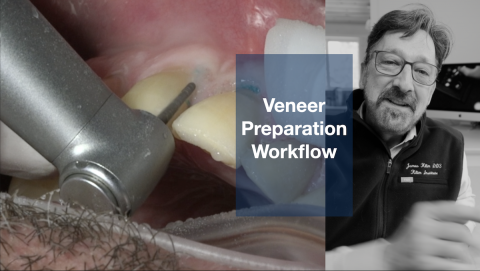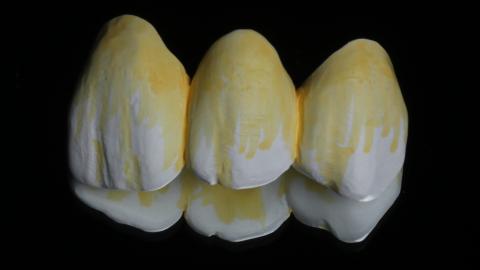This video is my typical veneer bonding workflow. Though I now use Variolink Esthetic Dual Cure for easy cleanup, the light cure Variolink Esthetic is used in this video. This video is a bit long. Let me know how these longer videos work for you.
Submitted by James Klim DDS, CADStar host on 09/01/2023 - 5:42pm
Submitted by James Klim DDS, CADStar host on 08/11/2023 - 4:14pm
Over the last 12 years, my veneer trend has been to preserve more and more tooth enamel and engineer thinner veneers. I preserve at least 50% enamel surface or more for a strong adhesive interphase to enamel. A material like e.max has helped this journey due to its robust nature allowing our veneer applications to go down to 300 um and less than 50 um on the margins. This video is about my preparation strategy when I prep. And this case has it all, breaking contact on some of the preps, minimal prepping on others, and then almost no prepping on the premolars and molars.
Submitted by James Klim DDS, CADStar host on 06/23/2023 - 5:57pm
The workflow present in the video is the strategy I use to complete a veneer case in the same appointment. Several pointers will help the process. One, go in with a mock-up and complete the projects in sections, so the milling starts early in the appointment. Two, have a predictable design and milling strategy, have the glaze coloring system down, and gain outstanding results.
Submitted by James Klim DDS, CADStar host on 05/29/2023 - 5:51pm
MiYO Esthetic is the magic layer to our zirconia aesthetic restorations. With this material, I can intermix and blend with adjacent e.max restorations. With the aesthetic zirconia, choose one to two shades darker than the target shade, and place MiYO Esthetic on just the buccal/labial surface. This video will demonstrate using MiYO Esthetic on an anterior ZirCAD MT Multi zirconia bridge.
Submitted by James Klim DDS, CADStar host on 05/29/2023 - 3:26pm
The most optimal zirconia surface wear against a natural dentition is polished zirconia. It is kinder than a class IV gold. This video will break down the steps and polishing tools to effectively polish the anterior bridge's lingual and pontic tissue surfaces. However, leave the labial surface unpolished to retain the surface texture for MiYO Esthetic application.
Submitted by James Klim DDS, CADStar host on 05/29/2023 - 2:54pm
Infiltration may not be necessary in every anterior zirconia bridge case. However, it will come in handy for cases with deeper cervical dentin saturation and does help in creating the illusion of separations for the pontic. This video will illustrate applying a single infiltration color using ZirCAD LT Coloring liquids on a ZirCAD MT Multi zirconia anterior bridge. When infiltration is applicable for the case, this is applied in the green zirconia condition, and the restoration is sintered using the added drying cycle in the CS6 and the SpeedFire.
Submitted by James Klim DDS, CADStar host on 05/28/2023 - 1:13pm
With the evolution of aesthetic zirconia, I am finding applications for the anterior aesthetic zone. There is a trifecta solution that will enhance the outcome, shaping and texturing, infiltration, and application of MiYo Esthetic colors and glaze. With this combination of ZirCAD MT Multi, Infiltration, and MiYO Esthetic, I can now interexchange with e.max on anterior smile cases and comprehensive care. This video will demonstrate what we do when the zirconia comes out of the milling unit before sintering.
Submitted by James Klim DDS, CADStar host on 04/17/2023 - 8:46pm
The video will rate my favored Stain and glaze systems for ceramics and zirconia. The top of my list is Ivocoloar by Ivoclar, MiYo 850, and MiYo Esthetic by Jensen. These systems are taking our monolith restoration to a new level. Do we need them all, or is there a universal option?
Submitted by James Klim DDS, CADStar host on 03/22/2023 - 12:42pm
MiYO 850 has transformed my aesthetic clinical theater for e.max. By adding 850 glaze and colors for the crystallization firing, saves significant clinical time, and elevates the aesthetic outcome for e.max. This video is the one-step for creating a natural incisal edge and applying the glaze and colors on a blue e.max block.
Submitted by James Klim DDS, CADStar host on 02/09/2023 - 6:52pm










